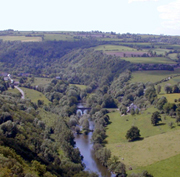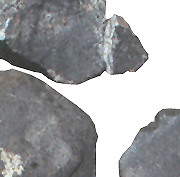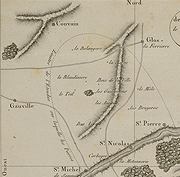Official Name:
L'Aigle is the name of the village near which this meteorite shower rained down.
Location:
L'Aigle is 140 kilometres northwest of Paris. It is located in lower Normandy, department of Orne, France.

Enlargement
The Orne Valley region where the L'Aigle shower fell. |
|

Enlargement
A few fragments of the L'Aigle meteorite from the collection of the Naturhistorisches Museum, Vienna, Austria. |
|
Fall or Find:
L'Aigle is a fall with historic importance.
Date:
26 April 1803, about 1 p.m., local time.
Mass Recovered:
A total of 37 kilograms of meteoritic materiel was collected from this shower.
Number of Fragments:
Between 2 000 and 3 000 fragments fell from the sky. The largest one weighed 9 kilograms.
Strewn field:
The rocks bombarded an area 10 kilometres long by 4 kilometres wide. The largest fragments were all found at the extreme northwest end of the ellipse. This was the first strewn field ever mapped in history.
Circumstances:
The meteoroid crossed the sky from southeast to northwest. Several witnesses, including some French magistrates, saw the fireball. Explosions were heard, and then rocks began raining down from the sky.
History:
The French Minister of the Interior commissioned the young physicist Jean-Baptiste Biot to investigate the nature and extent of the fall. Biot stopped in several villages on his way to L'Aigle to ask witnesses about the fireball. He also visited industries in the region, noting that none of them produced anything similar to the rocks that had fallen from the sky. Biot wrote an eloquent report in which he declared that the L'Aigle rocks were indisputably of extraterrestrial origin.

Enlargement
The physicist Jean-Baptiste Biot. As a young man, he mapped the strewn field of the L'Aigle shower. |
|

Enlargement
The strewn field of the L'Aigle shower, drawn by Jean-Baptiste Biot. |
|
Type:
Stony meteorite
Class:
Ordinary chondrite
Group:
L6
Composition:
Within days after the fall, fragments of the L'Aigle meteorite were sent to Paris. Many scientists analyzed the fragments. They discovered that the L'Aigle fragments resembled fragments from other meteorite falls. The scientists also noted the presence of nickel in the fragments. The L'Aigle chondrite contains 22.8% iron. It does not have many chondrules, and the few that it does have are difficult to make out.
Scientific contribution:
The report describing the phenomena connected with the L'Aigle shower made it clear that rocks really could fall from the sky. Biot's conclusions supported statements that several scientists were just beginning to make about the origin of meteorites.
Comments:
After the L'Aigle shower, private and public meteorite collections began to grow. Today, meteorites from L'Aigle can be found in most collections around the world. To celebrate the bicentennial of this historic fall, the Musée de la
Météorite in L'Aigle created a permanent exhibit about the fragments from the shower.
Part of the Planétarium's collection:
Yes